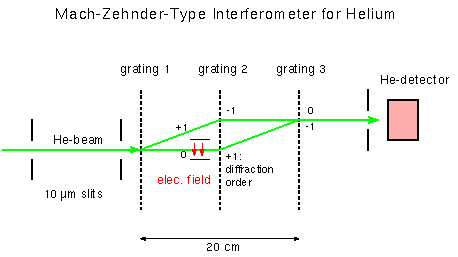
Matter Wave Interferometer |
|---|
Interferometers with light have been employed for about 150 years and the work with these instruments has brought about tremendous progress in the understanding of physics. Such devices for matter waves can be expected to render similarly great contributions. Since de Broglie's hypothesis of the wave nature of matter, interferometry with atoms has become possible. The wavelength of a de Broglie wave, λ, is determined by the momentum, p, of the particle and is given by the formula
The essential ingredient of any interferometer is a device which allows one to split the beam into spatially separated components without destroying the coherence of the waves. Such beam 'splitters' were found to exist for electrons and also for neutrons in terms of the periodic structures of single crystals. Thus, for about 40 years, interferometry with electrons and neutrons has been successfully performed. For atoms this is a considerably more difficult task and only recently has such a venture been successful (Keith et al., Phys. Rev. Lett. 66, 2693 (1991).

The purpose of first grating is to split the incoming beam into two separate, coherent outgoing beams. Considering the wavelength in our thermal energy helium beam and the lattice parameter of the grid one finds that the angle between the zero order and the first order diffraction beams, Θ =λ/d turns out to be 1 mrad, leading to a spatial separation of the two beams on the second grating of 0.1 mm. Since the beams are merely 0.01 mm wide they are well separated.